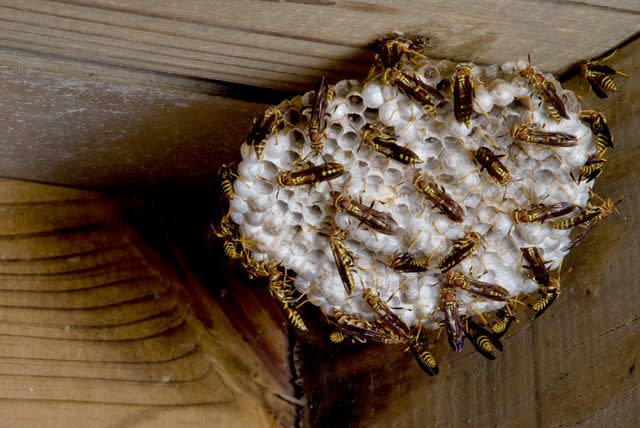How To Get Rid Of Yellow Jackets
Here’s how to keep these wasps away from your family.
Wasps do plenty of good in our gardens, pollinating plants and preying on hungry garden pests, such as caterpillars. But then there are yellow jackets (Vespula spp), which become aggressive as their populations soar in mid- to late-summer and fall. They can become a big problem if their nests are situated near your living areas.
How can you tell what kind of wasp you’re dealing with? And how do you get rid of them?
Meet The Expert
Mike Raupp, PhD, is Professor Emeritus of Entomology and Extension Specialist at the University of Maryland
Sydney E. Crawley, PhD, is Assistant Professor and Extension Specialist, Urban and Structural Entomology at North Carolina State University.

Getty Images / robeo
What Are Yellow Jackets?
Many types of wasps are solitary. They’re lone females who care only about feeding their babies; solitary wasps are not aggressive and don’t sting in defense. “Yellow jackets are a kind of social wasp, which live in a colony with a queen,” says Mike Raupp, PhD, Professor Emeritus of Entomology and Extension Specialist, at the University of Maryland. “Their colonies grow rapidly and contain thousands of workers by late summer, which is when they become aggressive because of the increasing demand for food for the growing colony.”
Most of the time, these wasps are out pollinating and foraging and aren’t worried about what you’re doing in and around your garden. But that can change in an instant if you accidentally annoy them. “Yellow jackets can become very aggressive if you interrupt their activities or disturb their nests,” says Sydney E. Crawley, PhD, Assistant Professor and Extension Specialist, Urban and Structural Entomology, North Carolina State University.
You may not even know you’re near a nest until yellow jackets come streaming out in full battle mode, ready to attack and sting the intruder. Vibrations from mowing, string trimming, hedge trimming, or even walking by a nest causes them to alert.
Unlike bees, yellow jackets and other wasps can sting multiple times, which can lead to allergic reactions and in rare cases, anaphylactic shock. “Children and elderly individuals are more susceptible to severe reactions,” says Crawley.
(Read more here about how to keep bees away from your house, how to keep wasps away from your home, and how to keep carpenter bees away).
Identifying Yellow Jackets
Yellow jackets are about 3/8 to 5/8 of an inch long with a shiny yellow and black striped abdomen and clear-ish wings. They’re roughly the same size as honeybees, but they don’t carry pollen like honeybees do in pollen baskets on their rear legs. They fly with a side-to-side pattern before landing.
Different species have different nesting habits, says Raupp. They nest in the ground or wall voids, behind shutters, or they may build aerial nests on shrubs, trees, and houses.
Yellow jackets stay active until late fall when a killing frost takes out the workers and males. The queen leaves the nest and overwinters in a sheltered spot, such as under tree bark. In the spring, she begins a new nest.
What Attracts Yellow Jackets?
By mid- to late-summer and fall, yellow jacket populations are at their height. “As their number build up, they gorge themselves and become more aggressive,” says Crawley. They forage for sugar and protein, which means meat, chicken, fish, fruit, sweets, and sweet beverages are all fair game.
How To Get Rid Of Yellow Jackets
For nests that must be eliminated, wait until evening to treat because too many workers are out foraging during the day, says Raupp. Use any type of aerosol wasp spray, but make sure it can spray 10 feet or more so you don’t need to get too close. Spray directly into the hole and do not shine a flashlight inside of the opening. Stay away from the nest for at least a day.
Nests that are located in out-of-the-way spots, such as the back of your property, don’t need to be destroyed. They’re going to die off anyhow when cold weather arrives, says Raupp. (That is, except for some areas in the Lower South, where yellow jacket colonies can be perennial and will require elimination by a professional pest control company).
Both Raupp and Crawley caution that if you are allergic to stings or have a nest inside a wall or an aerial or perennial nest, call a professional pest control company. Also, don’t try to plug the entry to a nest that’s in a wall. That just forces angry yellow jackets to find another exit, and they can chew through wallboard to escape (yikes!) and emerge indoors, says Crawley.
How To Prevent Yellow Jackets
· Keep your trash cans covered and far away from living spaces, and wash them regularly to rinse out residues which can attract yellow jackets, says Crawley.
· Don’t set up your picnic in the park at the table nearest to the trash cans, which are a favorite foraging spot for yellow jackets, says Raupp.
· Use fine mesh food covers to keep wasps and flies away from your food when dining outdoors. Clean up spills on surfaces promptly.
· Pour drinks out of a soda can into a lidded cup so wasps don’t fall into the cans and sting you. This also goes for kids’ drinks, too, which should be a juice box or in a covered cup, says Raupp.
· Avoid the urge to swat foraging yellow jackets who are investigating your picnic. Instead, use a napkin to gently shoo them away “Aggressive moves will provoke an aggressive response,” says Raupp.
· If you have fruit trees or a garden, pick up fallen fruit and veggies so they won’t ferment and attract foraging wasps, says Crawley.
For more Southern Living news, make sure to sign up for our newsletter!
Read the original article on Southern Living.

